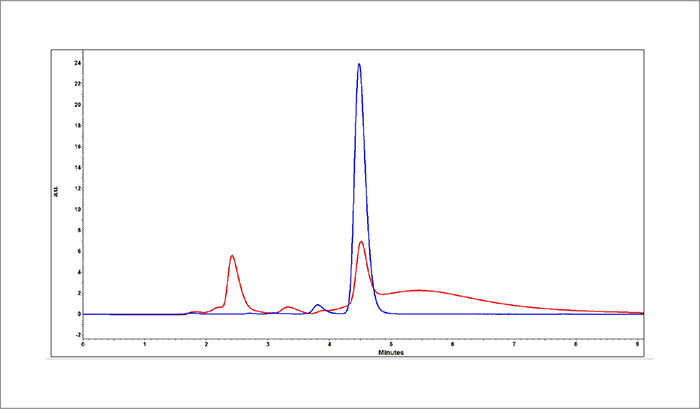Aflatoxins are the best known group of mycotoxins (naturally occurring mushroom poisons) and can accumulate on crops during storage of agricultural products, especially under warm and humid conditions. The maximum aflatoxin M1 level set by the U.S. Food and Drug Administration and European Commission is 0.5 µg/L. The application describes a fast and isocratic method applicable for the required detection limit of aflatoxin M1. First, the analytical method was developed using a standard solution: standard concentration of 1 µg/mL aflatoxin M1 with fluorescence detection and post column derivatization using the UVE photochemical reactor. To make sure that the legal limit value is detectable, a milk sample was spiked with aflatoxin M1 to a concentration of 0.5 µg/L and pretreated with online solid-phase extraction (SPE). Figure 1 shows an overlay of the spiked milk sample after sample preparation and the aflatoxin M1 standard. Although matrix effects occur through SPE pretreatment, it was possible to quantify aflatoxin M1 in the measured milk sample spiked down to 0.5 µg/L. For sample pretreatment the following SPE procedure was conducted: 20 mL of the spiked milk was diluted with 30 mL distilled water. A CHROMABOND® C18 ec SPE column was conditioned with 10 mL water and 10 mL n-hexane. Afterwards, the column was dried for 10-20 min at 50°C or overnight at ambient temperature. After drying, the sample was eluted with 3 mL acetonitrile.


An AZURA® Analytical HPLC Plus system was used for this application. It consisted of an AZURA® P 6.1L low pressure gradient pump, an autosampler 3950, a column thermostat CT 2.1, the UVE photochemical reactor and fluorescence detector RF-20Axs. The analytical method was run isocratically at a flow rate of 0.8 mL/min with a mixture of water, methanol and acetronitrile 60:25:15 (v/v/v). The column thermostat was set to 30°C and the detector was set to excitation 365 nm/emission 455nm. The sensitivity was adjusted to ‘high’ with a gain of 16. The used column was filled with KNAUER Eurospher II 100-3 C18 silica. Using the UVE photochemical reactor for post-column derivatization in combination with the AZURA® Analytical HPLC system and fluorescence detection, the valid maximum limit values of 0.5 µg/L for aflatoxin M1 in milk and other dairy products could be quantified.
Contact: Kate Monks, applications@knauer.net ,+49 30 809 727 0
http://www.knauer.net/de/applikation/determination_of_aflatoxin_m1_in_milk.html





